Breast cancer is not a single disease — it’s a group of biologically different subtypes with distinct behaviors, prognoses, and treatment strategies.
The classification is based on histology (cell type), hormone receptor status, HER2 status, and sometimes gene expression profiles.
Below is a comprehensive breakdown of the main subtypes and how treatments differ.
1. By Histologic (Cell Type) Classification
These describe the cancer’s microscopic appearance:
- Invasive Ductal Carcinoma (IDC) – ~70–80% of cases; begins in ducts, invades surrounding tissue
- Invasive Lobular Carcinoma (ILC) – ~10–15%; starts in lobules, often less distinct on imaging
- Other rare histologies:
- Tubular carcinoma
- Mucinous (colloid) carcinoma
- Medullary carcinoma
- Papillary carcinoma
- Metaplastic carcinoma
Treatment: Histologic type matters less for systemic therapy decisions than receptor status, but rare types sometimes have better prognosis and may respond differently to chemo.
2. By Hormone Receptor (HR) & HER2 Status
This is the most clinically relevant classification for guiding therapy.
| Subtype | ER (Estrogen) | PR (Progesterone) | HER2 | Typical Behavior | Main Treatments |
| HR-positive / HER2-negative | + | ± | – | Most common (~70%); slower growing; higher late recurrence risk | Endocrine therapy (tamoxifen, aromatase inhibitors), ± chemotherapy if high-risk (based on tumor size, grade, genomic assays like Oncotype DX) |
| HER2-positive (HR+ or HR–) | ± | ± | + | Aggressive but highly responsive to HER2-targeted drugs | HER2-targeted therapy (trastuzumab, pertuzumab, T-DM1, trastuzumab deruxtecan) + chemotherapy ± endocrine therapy if HR+ |
| Triple-negative breast cancer (TNBC) | – | – | – | ~10–15%; more aggressive; higher early recurrence risk | Chemotherapy mainstay; immunotherapy (pembrolizumab) in some settings; PARP inhibitors for BRCA-mutated cases |
3. By Molecular/Intrinsic Subtype
Determined by gene expression profiling (e.g., PAM50 test). These correlate with HR/HER2 status but refine prognosis.
| Molecular Subtype | Typical Clinical Match | Prognosis | Treatment Nuances |
| Luminal A | HR+, HER2–, low Ki-67 | Best prognosis; low recurrence | Endocrine therapy ± minimal chemo |
| Luminal B | HR+, HER2– or HER2+, high Ki-67 | Higher recurrence risk than Luminal A | Endocrine therapy + chemo; HER2 therapy if HER2+ |
| HER2-enriched | Often HER2+, HR– | Aggressive but HER2-targeted therapy effective | HER2-targeted + chemo |
| Basal-like | Often overlaps with TNBC | Worst prognosis without treatment | Chemo; immunotherapy; targeted agents for BRCA mutations |
4. By Stage & Other Special Types
Certain rare but clinically important forms:
- Inflammatory breast cancer (IBC) – Rapid onset redness/swelling; always stage III+ at diagnosis; needs neoadjuvant chemo, HER2 therapy if positive, then surgery & radiation.
- Paget’s disease of the nipple – Associated with DCIS or invasive cancer; treated surgically.
- Metaplastic breast cancer – Rare, chemo-resistant; clinical trial consideration.
- Male breast cancer – Usually HR+; treated similarly to postmenopausal women.
Treatment Overview by Subtype
| Subtype | First-Line Systemic Approach | Local Therapy | Emerging/Targeted Approaches |
| HR+ / HER2– | Endocrine therapy (tamoxifen, AIs, ± ovarian suppression in premenopause); chemo if high risk | Surgery + radiation depending on stage | CDK4/6 inhibitors, PI3K inhibitors (alpelisib) for PIK3CA-mutant |
| HER2+ | Chemo + trastuzumab ± pertuzumab | Surgery + radiation | T-DM1, trastuzumab deruxtecan, tucatinib in advanced disease |
| TNBC | Chemo ± immunotherapy (pembrolizumab in PD-L1+ or early high-risk) | Surgery + radiation | PARP inhibitors (BRCA-mutant), antibody-drug conjugates (sacituzumab govitecan) |
| IBC | Neoadjuvant chemo ± HER2 therapy | Modified radical mastectomy + radiation | Immunotherapy trials |
| Metastatic | Depends on receptor status | Palliative radiation for local control | Multiple targeted/novel agents in clinical trials |
Key takeaway:
- Receptor status (ER/PR/HER2) drives most systemic treatment choices.
- Histology gives insight into growth patterns and prognosis but less directly affects systemic therapy.
- Molecular profiling increasingly personalizes care, helping avoid overtreatment or undertreatment.
Breast Cancer Subtype & Treatment Pathway Chart
| Subtype | Key Features | Typical First-Line Systemic Treatment | Local Treatment | Targeted/Emerging Therapies |
| HR+ / HER2–(Luminal A & Luminal B) | ER+, PR+, HER2–; most common; slower growth in Luminal A, faster in Luminal B | Endocrine therapy (Tamoxifen, Aromatase Inhibitors ± ovarian suppression); Chemo if high-risk (Oncotype DX/Prosigna guided) | Surgery + radiation if indicated | CDK4/6 inhibitors (palbociclib, ribociclib, abemaciclib); PI3K inhibitors (alpelisib for PIK3CA mutation) |
| HER2+ (HR+ or HR–) | HER2 overexpressed; more aggressive without therapy | Chemo + HER2-targeted therapy (trastuzumab ± pertuzumab) | Surgery + radiation | T-DM1, trastuzumab deruxtecan, tucatinib (advanced/metastatic) |
| Triple-Negative (TNBC)(Basal-like) | ER–, PR–, HER2–; more aggressive; higher early recurrence risk | Chemo (anthracyclines, taxanes, platinum) ± immunotherapy (pembrolizumab for PD-L1+) | Surgery + radiation | PARP inhibitors (olaparib, talazoparib for BRCA-mutant); sacituzumab govitecan; clinical trials |
| Inflammatory Breast Cancer (IBC) | Rapid swelling/redness; always ≥ stage III | Neoadjuvant chemo ± HER2 therapy if HER2+ | Modified radical mastectomy + radiation | Immunotherapy & targeted therapy trials |
| Metaplastic Breast Cancer | Rare; chemo-resistant | Standard chemo | Surgery + radiation | Clinical trials, targeted agents in research |
| Male Breast Cancer | Usually HR+ | Endocrine therapy; surgery | Surgery ± radiation | Same targeted therapies as postmenopausal women with same receptor status |
| Paget’s Disease of Nipple | Eczematoid nipple lesion; often with DCIS/invasive | Depends on underlying tumor subtype | Surgery (often mastectomy) ± radiation | Guided by receptor status |






Leave A Comment